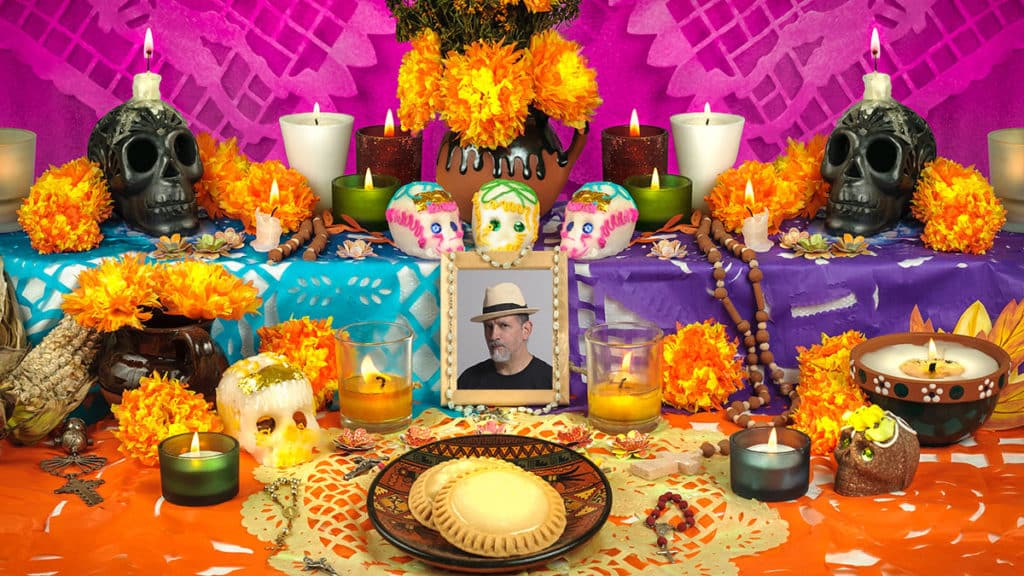Day of the Dead NYC 2022 (Día de los Muertos) is a family tradition of remembering ancestors and tending their graves. There is nothing bad or scary about it.
As a blend of American and European traditions, the celebration takes many forms around the world, including in Brazil, Ecuador, El Salvador, Guatemala, Haiti, Philippines, and Spain.
Depending on the country, celebrations may be more Indigenous, European or African. But most of the world’s traditional religions venerate the ancestors. That’s also true in Asia and Europe’s traditional religions. The Gaelic (Ireland and Scotland) tradition of Samhain, which Americans celebrate as Halloween, is similar. The Hindu festival of Mahalaya is similar.
The Mexican form blends Aztec & Mayan, Catholic, and U.S. Halloween traditions into something unique that is beloved worldwide.
Day of the Dead NYC 2022
The Day of the Dead NYC 2022 Día de los Muertos is a family celebration of life over three days, Monday-Wednesday, October 31 – November 2, 2022. 🇲🇽
The Queens Museum Día de Los Muertos Ofrenda (community altar) is on view at the Queens Museum in Flushing Meadows Corona Park, from October 5 – November 2, 2022. queensmuseum.org 🇲🇽
NYC’s Latin Grammy winning, all-woman, Mariachi band, Flor de Toloache, stars with Los Lobos and Ozomatli in the new PBS musical special, “Día de los Muertos” which premieres on WNET Thirteen, on Friday, October 28,2022 at 9pm. Free. 🇲🇽
Calpulli “Día de los Muertos,” dance theatre about the Day of the Dead, the Mexican family celebration of life, is at Hostos Center in Mott Haven, The Bronx on Saturday-Sunday, October 29-30, 2022 (Sat 8pm, Sun 3pm). $25. Hurry, we expect a sell-out! hostos.cuny.edu 🇲🇽
Day of the Dead Celebrates Life
The Mexican tradition of Día de Muertos has become popular worldwide, partly through the striking skeleton drawings of “La Calavera Catrina” by Mexican cartoonist José Guadalupe Posada (1852-1913).
The Indigenous tradition goes back to the Aztec festival honoring Mictlancihuatl, the Aztec queen of the underworld. It was originally around the beginning of August. Catholic priests associated the festival with the Roman Catholic equivalent which is All Souls Day.
In many Native American traditions the worlds of the living and the dead are like two rooms in the same house. Death is not frightening. In some Native American traditions, the bones of family members were kept in the home. You could still speak with Grandma, by talking to her bones. In a way, she was also keeping an eye on you, so you had to be responsible. Catholic priests imagined darkness in this and tried to change the tradition to All Souls Day. There is no darkness here. It’s a beautiful family tradition, a celebration of life, actually.
The Day of the Dead comes from southern Mexico. Today it is celebrated across the country. The Mexican government made it a national holiday to help unite the country around culture.
Ofrendas are Family Altars
Part of the Day of the Dead tradition is the creation of home altars to invite family souls to visit. They only visit if you invite them, if you remember them.
Altars are decorated with mementos of the deceased. Marigolds, sugar skulls, and paper cutouts are traditional. Marigolds are thought to attract the dead.
Toys are put out for child souls. Drinks are put out for adult souls. Food and sweets are put out for all.
It’s a party filled with family and fun. Why else would souls come back to visit?
Day of the Dead is a Three-Day Celebration
Most people focus on Day of the Dead, November 2, but the tradition is a three-day celebration.
- October 31 ~ Build Ofrendas (Altars)
- November 1 ~ Día de los innocentes (Children’s Day or All Saints Day)
- November 2 ~ Día de muertos (Day of the Dead or All Souls Day)
The dead spirits of children visit on October 31st. Adult spirits visit on All Saints Day, November 1st. Families clean and decorate the graves of passed family members on All Souls Day, November 2.
By the way, in Mexico, it’s Día de Muertos. Americans translate “Day of the Dead” back into Spanish as Día de los Muertos, but that is American Spanish. It’s okay. Our country is the second biggest Spanish-speaking country after Mexico.

